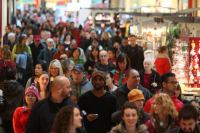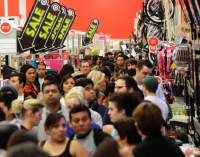Crowd Management – The Retail Perspective

Crowds are a normal part of running a retail business. Coming off a holiday season and being well into 2013, security professionals are now taking the time to revisit and revise their plans for the year ahead.
The 2012 holiday season was full of new and exciting events and promotions at retail stores, giving loss prevention professionals new reasons to be extra vigilant with their preparations. One of the biggest changes last year was the addition of Thanksgiving night shopping, with many companies opening their doors as early as 9:00 PM that night. Though there were outcries from employees and civic groups about these extended holiday shopping hours, hundreds of thousands of anxious holiday shoppers across the country lined the sidewalks as early as 7:00 PM in anticipation of the big openings, eager to get their hands on hot holiday deals.
While holiday shopping levels don’t quite mirror the lower levels that retailers see through the rest of the year, retailers still have to be very resourceful in order to attract customers and drive traffic to their stores amidst the challenging economy. Special events and promotional sales are now a bigger part of the way retailers operate. Some of these events include:
Thanksgiving/Black Friday midnight openings
Limited quantity sale items
Game and video releases
Buy one get one free sales
Incredibly low prices
Giveaways
Smartphone releases
Celebrity appearances
Sneaker releases
Designer brand launch events
Retailers are not alone in trying to create enjoyable customer “experiences” by hosting special events. Mall management and property development companies also court shoppers using enticing events.
Planning puts retailers in the driver’s seat when events occur. Knowing in advance the date, time, expected attendance, and even anticipated loss leaders (the most likely items to be broken or stolen) puts store managers and employees in a better situation to handle the crowds, as well as come up with contingency plans. But even the best laid plans can go awry. Preparation and practice are two key elements that will help companies and security professionals feel more equipped to handle what comes their way when dealing with crowds.

A relatively new issue for retailers—“Flash Mobs,” or groups of people who organize through social media, assemble suddenly in a public place, and perform an unusual (sometimes seemingly pointless) act for a brief period of time, then disperse—not only disrupt business operations but often serve as a loss prevention nightmare. Many of these random “performances” or “pranks” are intended to be benign in nature, sometimes getting a good laugh; however, criminals take their own spin on this type of tactic to commit multiple offender crimes, also known as criminal flash mobs. These incidents wreak havoc on businesses, cause safety concerns for customers and employees, and directly impact a retailer’s bottom line.
Retailers agree that the top priority in event planning is safety—the safety of customers, associates, service providers, and security personnel. Proactively planning and preparing for any scenario helps increase the chances for a successful event. However, incidents such as criminal flash mobs, civil disturbances, parades and rallies, citywide meetings, and other unplanned events can wreak havoc on the best laid plans. Teams with a plan already in place are in the best position to minimize any potential crisis. These plans also help ensure the shopping experience is a positive one for the customers when the unforeseen arises.

Contingency plans are also created for the “what if” situations that may arise, including larger-than-anticipated crowds, inclement weather, power outages, large lines of angry customers, trampling incidents, active shooters, and merchandise sell-outs. Business continuity and emergency preparedness plans guide employees in the right direction when it comes to unexpected situations. Contingency plans can also include alternative entry/exit points for customers, celebrity guests, associates, and security/law enforcement. Important components of crowd management guidelines also include safety considerations, detailed communication plans, logistical arrangements, merchandise placement, and coordinating with the appropriate internal and external partners, such as law enforcement. Retailers continuously work to communicate before, during, and even after an event with public sector partners in law enforcement and the community to better provide safe environments for their customers and employees.
The challenging economy has played an integral role in how retailers interact and engage with their customers as stores aim to become a part of an individual’s lifestyle rather than merely a place to purchase everything on their checklist. These new initiatives almost always draw crowds and set the stage for increased levels of security; however, measures put in place to mitigate risks that may occur with any large crowd sets everyone up for success.
Angélica Rodríguez, Sr. Director, Loss Prevention, National Retail Federation
In Collaboration with Melissa Bradley, COPS Office
Work in Progress — From Tragedy to Healing: Oak Creek, Wisconsin | COPS Office Micro-Grants: Small Investments, Big Results | A Role for Officers in Schools | Training the Trainer: The PACT360 Learning Center | Crowd Management – The Retail Perspective | Did you know…?

